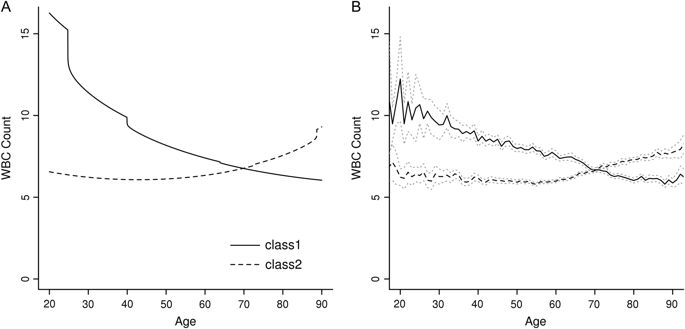当前位置:
X-MOL 学术
›
Genes. Immun.
›
论文详情
Our official English website, www.x-mol.net, welcomes your feedback! (Note: you will need to create a separate account there.)
Unfolding of hidden white blood cell count phenotypes for gene discovery using latent class mixed modeling.
Genes and Immunity ( IF 5 ) Pub Date : 2018-11-21 , DOI: 10.1038/s41435-018-0051-y Taryn O Hall 1 , Ian B Stanaway 1 , David S Carrell 2 , Robert J Carroll 3 , Joshua C Denny 3 , Hakon Hakonarson 4 , Eric B Larson 2 , Frank D Mentch 4 , Peggy L Peissig 5 , Sarah A Pendergrass 6 , Elisabeth A Rosenthal 7 , Gail P Jarvik 7 , David R Crosslin 1
Genes and Immunity ( IF 5 ) Pub Date : 2018-11-21 , DOI: 10.1038/s41435-018-0051-y Taryn O Hall 1 , Ian B Stanaway 1 , David S Carrell 2 , Robert J Carroll 3 , Joshua C Denny 3 , Hakon Hakonarson 4 , Eric B Larson 2 , Frank D Mentch 4 , Peggy L Peissig 5 , Sarah A Pendergrass 6 , Elisabeth A Rosenthal 7 , Gail P Jarvik 7 , David R Crosslin 1
Affiliation

|
Resting-state white blood cell (WBC) count is a marker of inflammation and immune system health. There is evidence that WBC count is not fixed over time and there is heterogeneity in WBC trajectory that is associated with morbidity and mortality. Latent class mixed modeling (LCMM) is a method that can identify unobserved heterogeneity in longitudinal data and attempts to classify individuals into groups based on a linear model of repeated measurements. We applied LCMM to repeated WBC count measures derived from electronic medical records of participants of the National Human Genetics Research Institute (NHRGI) electronic MEdical Record and GEnomics (eMERGE) network study, revealing two WBC count trajectory phenotypes. Advancing these phenotypes to GWAS, we found genetic associations between trajectory class membership and regions on chromosome 1p34.3 and chromosome 11q13.4. The chromosome 1 region contains CSF3R, which encodes the granulocyte colony-stimulating factor receptor. This protein is a major factor in neutrophil stimulation and proliferation. The association on chromosome 11 contain genes RNF169 and XRRA1; both involved in the regulation of double-strand break DNA repair.
中文翻译:

使用潜在类混合建模为基因发现揭示隐藏的白细胞计数表型。
静止状态白细胞(WBC)计数是炎症和免疫系统健康的标志。有证据表明,随着时间的推移,WBC计数不是固定的,并且在WBC轨迹中存在异质性,与发病率和死亡率相关。潜在类别混合建模(LCMM)是一种方法,可以识别纵向数据中未观察到的异质性,并尝试基于重复测量的线性模型将个体分类为组。我们将LCMM应用于从国家人类遗传研究所(NHRGI)电子医学记录和基因组学(eMERGE)网络研究参与者的电子病历中获得的重复WBC计数测量,揭示了两种WBC计数轨迹表型。将这些表型推向GWAS,我们发现轨迹类别成员与1p34.3号染色体和11q13.4号染色体上的区域之间存在遗传关联。1号染色体区域包含CSF3R,该CSF3R编码粒细胞集落刺激因子受体。该蛋白是嗜中性粒细胞刺激和增殖的主要因素。11号染色体上的关联包含RNF169和XRRA1基因;两者都参与双链断裂DNA修复的调控。
更新日期:2018-11-21
中文翻译:

使用潜在类混合建模为基因发现揭示隐藏的白细胞计数表型。
静止状态白细胞(WBC)计数是炎症和免疫系统健康的标志。有证据表明,随着时间的推移,WBC计数不是固定的,并且在WBC轨迹中存在异质性,与发病率和死亡率相关。潜在类别混合建模(LCMM)是一种方法,可以识别纵向数据中未观察到的异质性,并尝试基于重复测量的线性模型将个体分类为组。我们将LCMM应用于从国家人类遗传研究所(NHRGI)电子医学记录和基因组学(eMERGE)网络研究参与者的电子病历中获得的重复WBC计数测量,揭示了两种WBC计数轨迹表型。将这些表型推向GWAS,我们发现轨迹类别成员与1p34.3号染色体和11q13.4号染色体上的区域之间存在遗传关联。1号染色体区域包含CSF3R,该CSF3R编码粒细胞集落刺激因子受体。该蛋白是嗜中性粒细胞刺激和增殖的主要因素。11号染色体上的关联包含RNF169和XRRA1基因;两者都参与双链断裂DNA修复的调控。


























 京公网安备 11010802027423号
京公网安备 11010802027423号